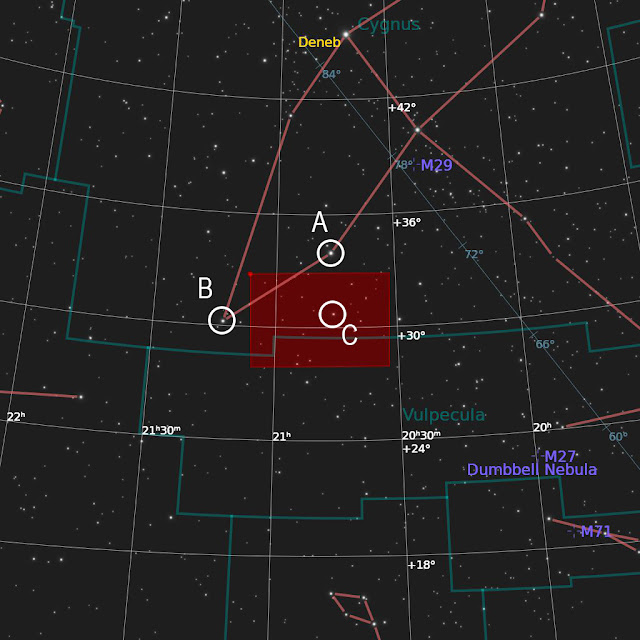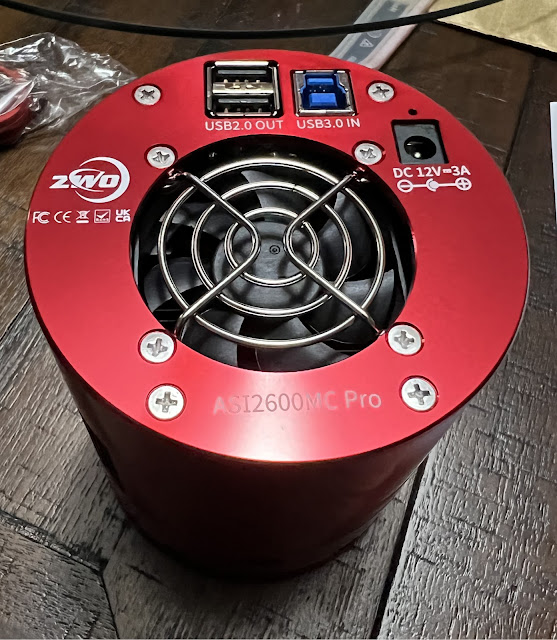Lots of celestial goodness in this field ...
On 7/18/2025, I captured this image of the Sadr region in the constellation Cygnus with my wide-field imaging rig.
 |
| A wide-field image of the Sadr region in Cygnus captured from my backyard on 7/18/2025. |
When processing Astro photos, it is common practice to separate the stars from the image. The stars and the object are then processed separately and recombined at the end. Here is the Starless image used to create the final image above.
 |
| A starless version of the image used in processing the data. |
What is it? (This section written with AI assistance)
 |
| An annotated version of the image. |
A few of the Celestial Objects in the image:
Gamma Cygni Nebula (IC 1318)
A sprawling emission complex centered on the bright star
Sadr (Gamma Cygni). It spans over a degree of sky and consists of two main
lobes of hydrogen-alpha emission, sometimes called the Butterfly Nebula. Dark
dust lanes weave through the red glow, tracing regions where cooler material
absorbs background light. The Gamma Cygni Nebula belongs to the Cygnus X star-forming complex.
Crescent Nebula (NGC 6888)
Carved by the powerful stellar wind of the Wolf–Rayet star
WR 136, this crescent-shaped bubble of ionized hydrogen glows vividly in red.
The fast wind has excavated a hollow shell in the surrounding gas, creating
sharp arcs and filamentary structures roughly 18 by 12 arcminutes in size.
Propeller Nebula (DWB 111/119)
Nicknamed for its propeller-like appearance,
this faint emission and reflection nebula lies just south of the Crescent.
Curved dust lanes and pockets of ionized gas form the “blades,” set against a
rich Milky Way star field. Also known as Simeiz 57. The Propeller Nebula is also part of the Cygnus-X star forming complex.
Open Star Cluster M29
A compact grouping of about 50 bluish and white stars, M29
sits a few degrees east of Sadr. At roughly 4,000 light-years away and 10
million years old, its hot young stars form a loose “V” or “Y” pattern,
contrasting with the surrounding nebular glow.
Notable Stars and Field Features
- Sadr
(Gamma Cygni): Magnitude 2.2 supergiant at the center of IC 1318, the
principal illuminating source.
- Field
Stars: Hundreds of fainter Milky Way stars pepper the background,
highlighting the vast scale of the nebular structures.
How Big is it?
The Gamma Cygni Nebula (IC 1318) has a size of 40 x 20 arcminutes (1 degree is 60 arcminutes) on the night sky and is about 17.5 light years across.
The Crescent Nebula (NGC 6888) has a size of 20.0 x 10. arcminutes (1 degree is 60 arcminutes) on the night sky and is about 31.6 light years across.
The Propeller Nebula (DWB 111/119) - I could not size information for this object.
M29 has a size of 10 arcminutes (1 degree is 60 arcminutes) on the night sky and is about 14.6 light years across.
How Far is it?
The Gamma Cygni Nebula (IC 1318) is located about 1,500 light-years (ly) in the Constellation Cygnus.
The Crescent Nebula (NGC 6888) is located about 5,400 light-years (ly) in the Constellation Cygnus.
The Propeller Nebula (DWB 111/119) is located about 4,600 light-years (ly) in the Constellation Cygnus.
M 29 is located about 5,000 light-years (ly) in the Constellation Cygnus.
How to Find it?
M29 can be observed visually. So can NGC 6888 (nebula filters and aperture will help). IC 1318 most likely can be observed visually; a wide field of view and nebula filter will help. The Propeller would be a very difficult visual observation.
The field of view of the image is shown below. The Star Sadr (Gamma Cygni) is naked eye visible in the Constellation Cygnus.
 |
| A finder chart for the image. |
Imaging Notes:
Friday July 18th was forecast to be clear at night. I set up my wide-field imaging rig before dark. Once it was dark enough, I polar aligned, calibrated PHD2, and slew to the target so I could focus the imaging camera and set the imaging camera rotation. Then I took my flat frames and initiated the imaging sequence for the night.
The first sub rolled in at 10:28 PM. The skies were really good, especially early in the night. I went to sleep around 1 AM. The rig kept collecting subs until 4:30 AM. A total of 103 good sub exposures were collected; four frames were discarded prior to processing.
Processing:
All pre and post processing was performed in PixInsight. Pre-Processing: All subs were visually inspected with Blink and subs with issues were removed. All light Frames, Flats, Darks and Dark flats were loaded into WBPP. Linear Post Processing: Background extraction was performed with GraXpert followed by BXT (correct only). SPCC was used for Color Calibration followed by a full application of BXT. The Stars were removed using StarXT. Starless Linear: Noise was reduced with NXT. The image was made non-linear with HT. Linear Stars: The stars were made non-linear with Seti Astro's Star Stretch Script.
Non-linear Post Processing: Starless: The Narrowband normalization process was used to get the "SHO look". Color, intensity, and contrast were adjusted with various applications of CT. Saturation was increased with CT. The Image blend Script was used to sharpen the image with a High Pass Filter. LHE was applied at 2 Kernel sizes and Unsharp mask was applied. CT was used to increase contrast. Stars: Saturation was increased with CT. SCNR was applied and the Correct Magenta Stars Script was used to help with stars captured with a dual narrowband filter. CT was used to adjust contrast one last time. Final: The Stars and Starless images were combined with Pixel Math to produce the final image.











































